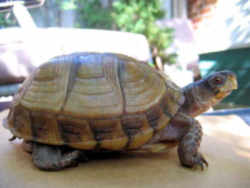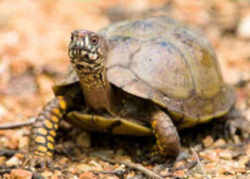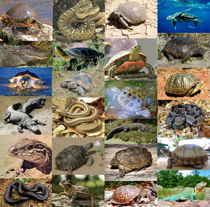
Missouri Symbols
Missouri State Reptile
Three-toed Box Turtle

(Terrapene carolina triunguis)
Adopted on June 21, 2007.
On June 21, 2007, the three-toed box turtle (Terrapene carolina triunguis) became the official state reptile. Most Missourians are familiar with this land-dwelling turtle. Three-toed box turtles, as their name implies, typically have three hind toes. The hinged bottom shell allows the turtle to retreat inside as if enclosed in a box. Males have red eyes and females have brown eyes. (RSMo 10.175).
Missouri State Reptile: Three-toed Box Turtle

The Three-toed box turtle (Terrapene carolina triunguis) is a subspecies within the genus of hinge-shelled turtles commonly referred to as box turtles. This subspecies is native to the south-central part of the United States and is the official reptile of the state of Missouri.
Shy and quiet are the traits of a Three-toed Box Turtle, both in its personality and in its coloring. Unlike the bold patterning and color seen on other eastern box turtles, the color of this species is quite subdued. Occasionally there will be a Three-toed that is more brightly colored, but for the most part they are a fairly uniform olive-brown to brown or horn color.
Description of the Three-toed Box Turtle
The carapace is highly domed and may range in color from tan or beige, to dark brown. Their shells may be marked with a variable assortment of spots, lines, a combination of the two, while some are completely void of any markings at all. The limbs may also be as variable in coloration as the carapace. Flesh coloration of dirty white, creamy yellow, tan, or brown may be present. The coloration of the scales present on the fore and hind limbs is often vividly contrasting enough to resemble the spilled paints on an artist's canvas. Scales of brick to vivid red, yellow, orange, and white easily disrupt the earth tone coloration of this turtle's other features. The face is often adorned in attractive colors. Variable patterns of white, red, purple, magenta, orange, and yellow are often found on the faces and heads of many individuals. However, facial coloration seems to bear the strongest contrast near the beak. On this area of the face many of the aforementioned colors can provide the appearance of a "mustache of color." The name "three-toed box turtle" is obviously due to the three toes found on their hind feet.
NATURAL HISTORY: These turtles occur in damp grasslands, within and at the edge of open deciduous and coniferous forest, and near permanent and temporary bodies of water. A study of microhabitat selection in the three-toed box turtle revealed that this species lives within a limited microhabitat range at all times during its annual activity (Reagan, 1974). The results indicated that the turtles selected humidity levels independent of prevailing conditions at the surface (Ernst, et al., 1994).
REPRODUCTION: Male three toed box turtles attain a larger size than the females and there may be a slight concavity to the posterior
of the male's plastron. This combined with strongly curved hind claws helps the males achieve mating success. Aside from these two features, male three-toed
box turtles tend to have a noticeably "redder" eye than the females. The tail normally allows a sure method to determine the sex. The male's
tail is longer and thicker than that of the female. In males, the cloaca may also extend beyond the posterior marginal scutes. However, these features
may vary from population to population. If in doubt an assessment of all characters thought to be sexually dimorphic should be made to help ensure
a correct sex determination.
Mating begins in the spring after the turtles are revived from hibernation. Females have the ability to produce up to four clutches of eggs from a
single mating by storing sperm cells in the lining of their oviducts. Long-term captive females in my care regularly lay their clutches of 2-7 eggs
in late June to early July. Incubation under artificial conditions takes about 70-80 days. Nesting is generally the only time when females will be
found active after dark.
Hatchlings are carnivorous and consume a wide variety of prey including, worms, insects, pill bugs, and other invertebrates. As the three-toed box
turtle matures, its diet shifts to include more vegetative matter. Adults are typically omnivores of broad culinary desires. Food items known to be
consumed by adults include: carrion, slugs, snails, beetles, worms, frogs, snapping turtle eggs, baby mice, grasses, fungi, bones, caterpillars, centipedes,
and crayfish.
Missouri Law
The law designating the three-toed box turtle as the official Missouri state reptile is found in the Missouri Revised Statutes, Title 2, Chapter 10, Section 10.175
TITLE II SOVEREIGNTY, JURISDICTION AND EMBLEMS
Chapter 10
State Emblems
Section 10.175
August 28, 2013
Three-toed box turtle, official state reptile.
10.175. The three-toed box turtle, scientifically designated as Terrapene carolina triunguis, is selected for and shall be known as the official reptile
of the state of Missouri.
(L. 2007 H.B. 272)
Taxonomic Hierarchy: Three-toed Box Turtle
Kingdom: Animalia
Phylum: Chordata
Subphylum: Vertebrata
Class: Reptilia
Order: Testudines
Family: Emydidae
Genus: Terrapene
Species: T. carolina
Subspecies: T. c. triunguis







